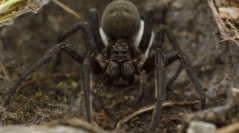

 Zoosystema
45 (1) - Pages 1-12
Zoosystema
45 (1) - Pages 1-12Vesubia jugorum (Simon, 1881) (Lycosidae Sundevall, 1833) is a wolf spider inhabiting high altitude rocky areas of the Southwestern Alps. Due to its restricted geographic range, its sensitivity to global warming and its continuing decline, this species has been recently assessed as Endangered (EN) by the IUCN Red List. On the basis of the research carried out in the recent years, we here provide updated information about its distribution, habitat characterisation, life history and conservation. Field observations and laboratory rearing suggest a multi‐annual life cycle for this species, with a growing season of five-six months and 10-12 instars to reach the adult stage. Adult males are found for a short period, and die after mating. During winter, adult females and immatures at different stages likely survive in the upper layers of the rocky debris under the snow, where the temperature remains stable around 0-2°C. Recent studies based on species distribution modelling have demonstrated a significant relationship between habitat suitability and functional traits related to species performance, which we briefly recall here. In light of this relation, a long-term monitoring programme was designed in collaboration with Parc national du Mercantour (France) and Parco Alpi Marittime (Italy), aiming at providing the conservation status of the species and possible future trends. Here, we present the results of the baseline phase of the monitoring programme, based on 17 sites across the French-Italian border, that confirm the positive relationship between functional traits and habitat suitability, and corroborate it as a practical, non‐invasive approach to the assessment of species health.
endemic species, monitoring, phenology, life cycle, climate change, habitat suitability, biodiversity conservation